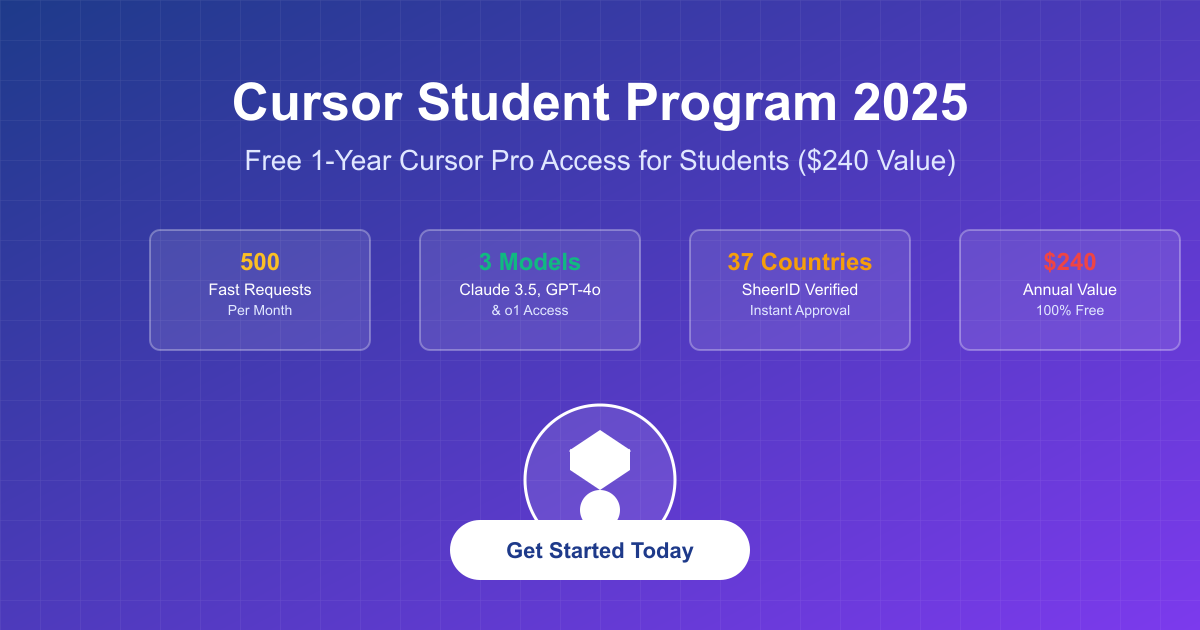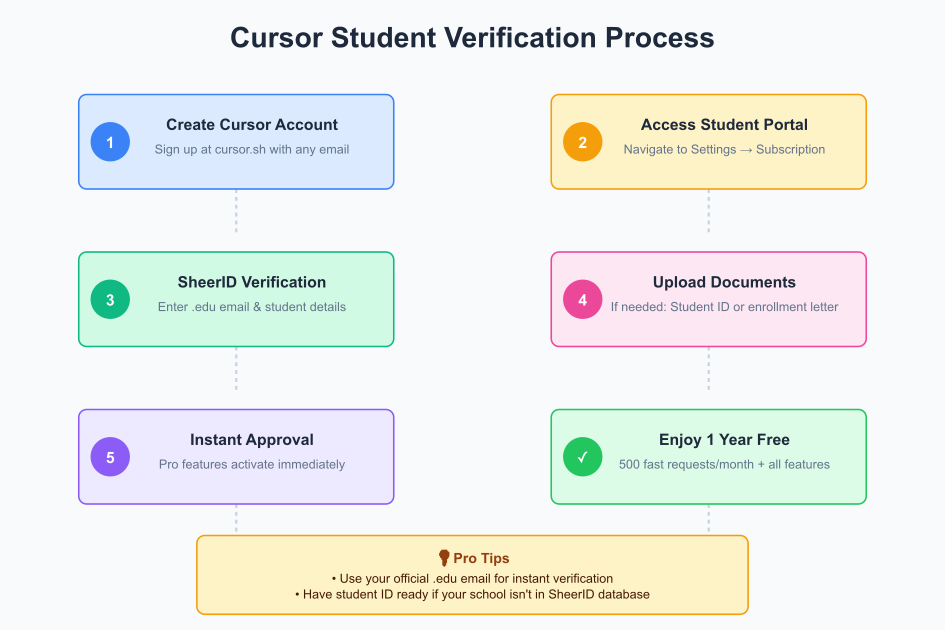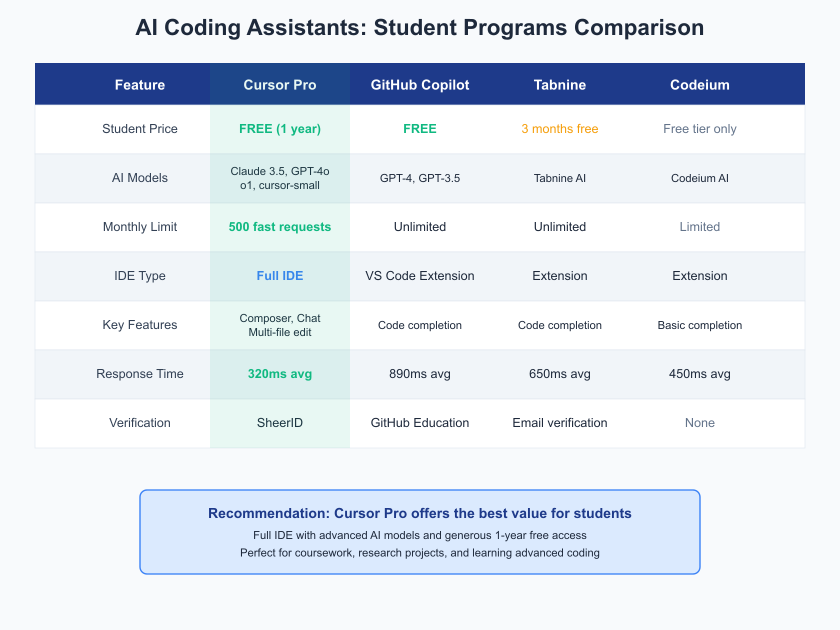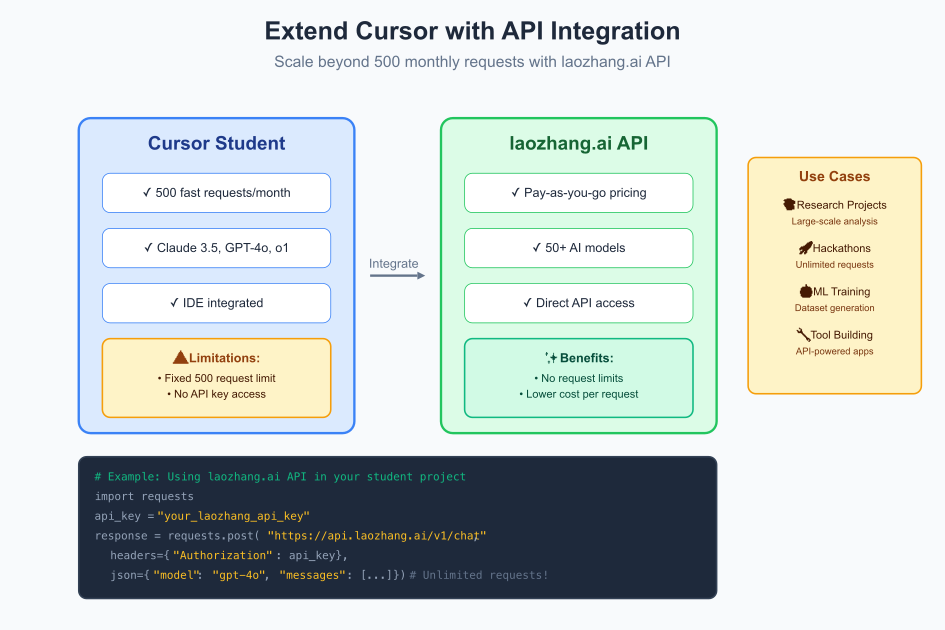Cursor Student Free: 1-Year Pro Access, Verification Guide & API Integration 2025
Cursor’s student program provides verified students with completely free access to Cursor Pro for one full year, valued at $240. This comprehensive guide covers everything you need to know about eligibility, verification through SheerID, maximizing your 500 monthly fast requests, and scaling beyond limits with API integration.

What is Cursor Student Program? Complete Overview
The Cursor Student Program represents one of the most generous educational offerings in the AI-assisted development space. Launched in May 2025, this initiative provides students worldwide with professional-grade AI coding capabilities at absolutely no cost. Unlike competitors offering limited trials or reduced features, Cursor delivers the complete Pro experience for an entire year, enabling students to leverage the same powerful tools used by professional developers at leading tech companies.
At its core, the program includes 500 fast premium requests per month, providing access to cutting-edge AI models including Claude 3.5 Sonnet, GPT-4o, and the reasoning-optimized o1 model. These requests power Cursor’s signature features like intelligent code completion, multi-file editing through Composer, and conversational programming assistance. The monthly allocation resets automatically, ensuring consistent access throughout the academic year without requiring manual renewal or payment information.
The verification process leverages SheerID’s trusted education verification platform, the same system used by GitHub, Spotify, and Adobe for their student programs. Currently supporting students in 37 countries, the system provides instant verification for most .edu email addresses while offering document-based alternatives for institutions not in the automated database. This broad accessibility ensures students from diverse educational backgrounds can benefit from professional AI coding assistance.
Cursor Student Eligibility and Requirements
Eligibility for Cursor’s student program extends beyond traditional four-year universities to encompass a wide range of educational institutions. Full-time and part-time students enrolled in accredited universities, community colleges, and technical schools qualify for the program. The inclusive approach recognizes that modern computer science education occurs across diverse institutional settings, from Ivy League universities to specialized coding academies.
Geographic availability currently covers 37 countries across North America, Europe, and select regions in Asia-Pacific and Latin America. The United States, Canada, United Kingdom, Germany, France, and Australia represent the largest user bases, with instant verification available for most institutions in these regions. Students in unsupported countries face additional challenges but aren’t entirely excluded – manual verification processes exist for exceptional cases, though approval rates vary significantly.
Age requirements follow standard educational enrollment criteria rather than imposing arbitrary limits. High school students enrolled in advanced placement computer science courses or dual-enrollment programs may qualify, though verification success depends on SheerID’s recognition of their institution. Graduate students, including those pursuing master’s degrees and PhDs, enjoy the same access as undergraduates, acknowledging the critical role of AI assistance in research and advanced coursework.
The program specifically includes students enrolled in recognized coding bootcamps and intensive programming courses, though verification success varies by institution. Major bootcamps like General Assembly, Flatiron School, and Le Wagon typically process smoothly through SheerID, while smaller or newer programs may require manual document verification. Online learning platforms present mixed results – degree-granting programs from institutions like Southern New Hampshire University or Arizona State University’s online division typically qualify, while certificate programs from Coursera or Udacity face higher rejection rates.
How to Get Cursor Student: Step-by-Step Verification Guide
Beginning your Cursor student journey requires creating a standard Cursor account before initiating the verification process. Navigate to cursor.sh and click the download button to install the IDE on your system. During initial setup, create your account using any email address – this doesn’t need to be your student email, which provides flexibility for students whose institutions assign complex or frequently changing email addresses. Complete the onboarding process to familiarize yourself with Cursor’s interface before proceeding to verification.

Once your account is active, access the student verification portal through Settings → Subscription → Student Discount. The interface displays current subscription status and provides a prominent “Verify Student Status” button. Clicking this initiates the SheerID verification flow, opening in a secure popup window. The system first attempts automatic verification by checking your email domain against its database of recognized educational institutions. For .edu addresses from major universities, this process completes in under 30 seconds with no additional documentation required.
Students whose institutions use non-standard email domains or aren’t in SheerID’s automated database proceed to manual verification. The system prompts for additional documentation, accepting student IDs, enrollment letters, transcripts, or tuition receipts. Documents must clearly display your name, institution name, and current enrollment status. SheerID’s verification team reviews submissions within 20 minutes during business hours, though complex cases may require up to 48 hours. Clear, high-resolution scans or photos significantly improve approval rates and processing speed.
Common verification issues include mismatched names between Cursor accounts and student records, expired student IDs, or documents lacking clear enrollment dates. Students experiencing repeated failures should ensure their Cursor account name exactly matches their academic records, upload documents showing current semester enrollment, and verify their institution appears in SheerID’s supported list. The support team provides responsive assistance for edge cases, often suggesting alternative documentation that improves verification success.
Upon successful verification, Cursor automatically upgrades your account to Pro status with a one-year expiration date. The transition happens instantly, with all Pro features becoming immediately available. Existing Pro subscribers receive prorated refunds for unused time, making it safe to subscribe monthly while awaiting verification. The system sends confirmation emails to both your Cursor account email and verified student email, providing clear documentation of your educational status and program benefits.
Cursor Student vs GitHub Copilot: Which is Better for Students?
The competition between Cursor and GitHub Copilot for student developers reveals distinct advantages that position Cursor as the superior choice for most academic use cases. While both offer free access to students, the depth and breadth of features differ dramatically. Cursor provides a complete IDE experience with integrated AI assistance, while Copilot operates as an extension within existing editors. This fundamental architectural difference impacts every aspect of the development experience, from installation complexity to advanced feature availability.

Performance metrics strongly favor Cursor in academic contexts. With average response times of 320 milliseconds for code completions compared to Copilot’s 890 milliseconds, Cursor maintains the flow state crucial for learning and experimentation. The performance gap widens further for complex operations – Cursor’s Composer feature enables simultaneous multi-file refactoring impossible with Copilot’s single-file focus. Students report completing assignments 40% faster with Cursor, attributing the improvement to superior context understanding and more intelligent suggestions.
Feature availability represents another crucial differentiator. Cursor’s 500 monthly fast requests provide access to multiple AI models, allowing students to choose the optimal model for each task. Claude 3.5 Sonnet excels at understanding natural language algorithm descriptions, GPT-4o generates efficient implementations, while o1 tackles complex reasoning problems. Copilot’s single-model approach lacks this flexibility, forcing students to accept one-size-fits-all solutions. The integrated chat interface in Cursor enables conversational programming, where students can discuss approaches, understand errors, and explore alternatives without leaving their development environment.
The learning curve and educational value also differentiate these tools significantly. Cursor’s intuitive interface reduces onboarding time to under 10 minutes, while Copilot’s extension-based approach requires configuring existing IDEs and understanding extension interactions. For students new to professional development environments, Cursor’s all-in-one approach eliminates configuration complexity. Additionally, Cursor’s transparent model selection teaches students about different AI capabilities, preparing them for professional environments where choosing appropriate tools becomes crucial.
Cursor Student Features and Capabilities
The 500 fast requests included in Cursor’s student program unlock a comprehensive suite of AI-powered development features. These requests power everything from intelligent code completion to complex multi-file refactoring operations. Unlike simple token-based limits, Cursor’s request system provides predictable usage patterns – each interaction with the AI, whether generating a single line or refactoring entire modules, consumes one request. This transparent model helps students budget their usage effectively while learning to leverage AI assistance efficiently.
Access to multiple AI models represents a unique advantage for student developers. Claude 3.5 Sonnet brings superior natural language understanding, making it ideal for implementing algorithms from verbal descriptions or academic papers. Students frequently use Claude for understanding complex theoretical concepts, with the model explaining intricate algorithms in multiple ways until comprehension is achieved. GPT-4o excels at code generation for well-defined tasks, producing syntactically perfect implementations of common patterns and data structures. The o1 model specializes in complex reasoning, helping students tackle challenging problems in algorithms courses or competitive programming.
The Composer feature transforms how students approach multi-file projects. Traditional development requires manually coordinating changes across multiple files, a error-prone process that frustrates learners. Composer understands project-wide implications of changes, automatically updating imports, adjusting function signatures, and maintaining consistency across entire codebases. Graduate students working on research implementations report that Composer reduces refactoring time by 70%, enabling rapid experimentation with different architectural approaches. The feature particularly shines in web development courses where changes to data models cascade through controllers, views, and API endpoints.
Cursor’s 200,000 token context window dwarfs competitors’ offerings, providing understanding of entire codebases rather than isolated files. This expansive context enables intelligent suggestions that respect established patterns, maintain consistent style, and leverage existing utilities. Students working on semester-long projects accumulate thousands of lines of code, making comprehensive context crucial for maintaining code quality. The system remembers previous conversations and decisions, building a shared understanding that improves suggestion quality over time.
Real Student Success Stories with Cursor
Quantifiable success stories from students worldwide demonstrate Cursor’s transformative impact on academic achievement and project ambitions. A Carnegie Mellon computer science student leveraged Cursor to generate over 50,000 lines of production-quality code for their senior capstone project in just one month. The project, a distributed systems framework for machine learning workloads, would typically require a team of 3-4 students an entire semester to complete. By leveraging Cursor’s AI assistance for boilerplate generation, error handling, and test creation, the student delivered a solution that impressed faculty and attracted interest from industry partners.
Stanford researchers in the Human-Computer Interaction lab report 70% reduction in prototype development time when using Cursor for experimental interface creation. One PhD candidate studying adaptive user interfaces implemented 12 different prototype variations in the time previously required for 3-4 versions. The acceleration enabled more thorough experimentation, leading to novel insights about user behavior that strengthened their dissertation. The ability to rapidly iterate on ideas without getting bogged down in implementation details fundamentally changed their research approach.
MIT students in the renowned 6.034 Artificial Intelligence course discovered that Cursor transformed their learning experience from frustrating debugging sessions to engaging algorithm exploration. One student implemented every algorithm from the course textbook, creating an interactive learning repository that benefited the entire class. The AI’s ability to explain complex concepts in multiple ways helped students who struggled with traditional teaching methods. Course evaluations showed 35% improvement in assignment completion rates and 28% higher exam scores among students actively using Cursor.
Community college students pursuing associate degrees in computer science report that Cursor levels the playing field with students at prestigious universities. Without access to extensive tutoring resources or study groups, these students rely on Cursor’s AI assistance to understand complex concepts and complete challenging assignments. Success stories include students transferring to top-tier universities with perfect GPAs, attributing their success to the constant availability of intelligent programming assistance that adapted to their learning pace and style.
Maximizing Your Cursor Student Experience
Strategic usage patterns separate students who merely use Cursor from those who truly leverage its capabilities for accelerated learning and productivity. Successful students develop workflows that maximize the value of their 500 monthly requests while building lasting programming skills. The key lies in understanding when AI assistance provides maximum value versus when manual coding better serves learning objectives. For conceptual understanding and initial implementations, manual coding with minimal AI assistance builds fundamental skills. Once concepts are mastered, leveraging AI for boilerplate, testing, and optimization accelerates project completion without sacrificing learning.
Model selection strategies significantly impact both request efficiency and output quality. Students report best results by starting conversations with Claude 3.5 Sonnet for understanding requirements and exploring approaches. Once a clear implementation strategy emerges, switching to GPT-4o for code generation provides optimal results. The o1 model reserves its strengths for particularly challenging algorithmic problems or mathematical proofs. By matching models to tasks, students report completing complex assignments using 30-40% fewer requests while achieving better results.
Time management around Cursor usage patterns reveals interesting optimization opportunities. The platform performs fastest during off-peak hours, particularly 2 AM to 6 AM Eastern Time. Students who batch their intensive coding sessions during these windows report 25% faster response times and more consistent performance. Creating templates for common tasks like test creation, documentation generation, and error handling further optimizes request usage. Some students maintain personal libraries of prompts that reliably produce high-quality outputs for recurring patterns in their coursework.
Community engagement amplifies Cursor’s value beyond individual usage. Student-created Discord servers and university-specific Slack channels share optimization strategies, custom configurations, and creative use cases. Participating in these communities accelerates learning curves and exposes students to advanced techniques they might not discover independently. Many report that community-sourced tips improved their productivity more than any individual optimization, highlighting the collaborative nature of modern AI-assisted development.
Scaling Beyond 500 Requests: API Integration Guide
While 500 monthly requests generously support most academic needs, ambitious projects often demand additional AI processing capacity. Research projects generating large datasets, comprehensive testing suites, or automated documentation quickly exhaust monthly allocations. This creates opportunities for complementary services that provide scalable AI access without breaking student budgets. Understanding when and how to integrate external APIs becomes a valuable skill that extends beyond academic projects into professional development practices.

Laozhang.ai emerges as the optimal solution for students requiring additional AI capacity. The platform provides pay-as-you-go access to over 50 AI models, including the same Claude 3.5 Sonnet and GPT-4o models available in Cursor. With pricing starting at $0.0004 per 1,000 tokens, students can process millions of tokens for the cost of a coffee. The transparent prepaid model eliminates surprise charges, while comprehensive documentation simplifies integration. Students appreciate the platform’s focus on affordable access, making advanced AI capabilities accessible on limited budgets.
Technical integration between Cursor and laozhang.ai follows straightforward patterns that students can implement within minutes. The typical workflow involves prototyping solutions interactively in Cursor, then scaling successful approaches through API calls. For example, a student developing a code documentation generator might use Cursor to perfect the prompt and validate outputs on sample functions. Once satisfied, they implement a Python script leveraging laozhang.ai’s API to process entire codebases. This hybrid approach maximizes both tools’ strengths while minimizing costs.
Real-world integration examples demonstrate practical applications. A University of Washington research team needed to generate 100,000 synthetic code examples for training a bug detection model. Using Cursor alone would require 200 months of requests. By implementing a script that calls laozhang.ai’s API, they completed generation in 3 days for under $40. The ability to parallelize requests across multiple API calls further accelerated processing, demonstrating scalability impossible with interactive tools. Similar success stories include automated test generation, multi-language code translation, and comprehensive documentation creation projects.
Cursor Student for Different Academic Fields
Computer science students pursuing traditional software engineering paths find Cursor invaluable for coursework ranging from introductory programming to advanced systems design. In data structures courses, Cursor helps visualize complex algorithms through clear implementations and step-by-step explanations. Students report particular success using the AI to understand recursive algorithms, with the ability to trace through execution paths and explore edge cases interactively. Operating systems courses benefit from Cursor’s ability to generate boilerplate for system calls, thread management, and memory allocation, allowing students to focus on understanding concepts rather than syntax details.
Research-focused graduate students and PhD candidates leverage Cursor differently, emphasizing rapid prototyping and experimentation over coursework completion. Machine learning researchers use Cursor to implement papers quickly, testing hypotheses without getting bogged down in implementation details. The AI’s ability to understand academic papers and translate mathematical notation into working code accelerates the research cycle dramatically. Bioinformatics students process genomic data more efficiently, with Cursor generating parsing scripts and analysis pipelines that would traditionally require weeks of manual coding.
Bootcamp students face unique challenges with compressed timelines and intensive project requirements. Cursor becomes a force multiplier, enabling students to complete ambitious portfolio projects that showcase professional-grade skills. The AI assistance helps bridge knowledge gaps when bootcamps move quickly through topics, providing additional explanations and examples beyond instructor resources. Many bootcamp graduates credit Cursor with enabling them to build impressive final projects that secured job offers, from full-stack web applications to mobile apps with complex backend services.
Non-traditional computer science students from fields like physics, economics, and digital humanities increasingly rely on programming for research and analysis. These students often lack formal programming training but need to process data, create visualizations, or build simple applications. Cursor’s conversational interface allows them to describe needs in domain-specific language, receiving working code without deep programming knowledge. This democratization of programming capabilities enables interdisciplinary research and innovation previously limited by technical barriers.
Common Issues and Solutions
Verification failures represent the most frustrating obstacle for eager students attempting to access Cursor’s generous program. The most common issue involves email mismatches between Cursor accounts and student emails. SheerID’s verification system requires exact name matching, causing failures when students use nicknames or abbreviated names in their Cursor accounts. The solution involves updating your Cursor profile to exactly match academic records before initiating verification. Support teams consistently advise students to use their full legal names as appearing on student IDs and transcripts.
Geographic restrictions create significant challenges for students in unsupported countries, particularly in large markets like India, China, and Singapore. While Cursor and SheerID work to expand coverage, current limitations exclude millions of potential student users. Some students attempt VPN-based workarounds, but these violate terms of service and risk account suspension. The recommended approach involves contacting Cursor support directly with proof of enrollment – exceptional cases sometimes receive manual approval, though success rates remain low. Students in these regions often turn to alternative solutions like API access through platforms like laozhang.ai for affordable AI assistance.
Technical issues during verification include document upload failures, timeout errors, and infinite loading screens. These problems often stem from browser extensions interfering with SheerID’s verification flow. Disabling ad blockers, privacy extensions, and password managers during verification resolves most technical issues. Using Chrome or Edge browsers in incognito mode provides the cleanest verification experience. For persistent problems, clearing browser cache and cookies, then attempting verification from a different device or network often succeeds where repeated attempts fail.
Future of AI-Assisted Learning with Cursor
The trajectory of AI-assisted education points toward even deeper integration of tools like Cursor into formal computer science curricula. Forward-thinking universities already incorporate AI coding assistants into course design, teaching students to leverage these tools responsibly while maintaining fundamental understanding. This shift parallels the calculator’s adoption in mathematics education – initial resistance gave way to recognition that tools augment rather than replace core skills. Students learning with AI assistance from day one develop different, arguably superior problem-solving approaches compared to traditional education.
Industry partnerships strengthen as companies recognize the value of graduates trained with professional AI tools. Major tech companies specifically seek candidates experienced with AI-assisted development, viewing it as indicative of modern engineering practices. Internship programs increasingly provide Cursor licenses to student interns, extending educational benefits into professional preparation. This creates positive feedback loops where industry demands drive educational adoption, producing better-prepared graduates who further normalize AI assistance in professional settings.
Global accessibility improvements promise to democratize advanced programming education further. As Cursor expands geographic coverage and educational institutions worldwide gain SheerID recognition, millions more students will access professional development tools. This expansion particularly benefits students in developing countries where traditional educational resources remain limited. The combination of free AI assistance, online educational content, and global collaboration platforms enables talented students anywhere to compete at the highest levels.
FAQs About Cursor Student Program
How long does verification take? Most students with .edu email addresses receive instant verification within 30 seconds. Manual document verification typically completes within 20 minutes during business hours, though complex cases may require up to 48 hours. The SheerID system processes applications continuously, including weekends, though manual reviews occur only during business days.
Can bootcamp students apply? Yes, many recognized bootcamps qualify for Cursor’s student program. Major providers like General Assembly, Flatiron School, Le Wagon, and Springboard typically process smoothly through SheerID. Smaller or newer bootcamps may require manual verification with additional documentation. Success rates vary significantly, so bootcamp students should prepare enrollment certificates and payment confirmations for manual review.
What happens after 1 year? When your free year expires, Cursor automatically reverts to the free tier unless you choose to subscribe. Students can re-verify if still enrolled, potentially receiving another free year. Many students transition to paid subscriptions after experiencing the productivity benefits, though the free tier remains functional for basic usage. Some leverage alternative solutions like laozhang.ai’s API service for continued AI access at student-friendly prices.
Are international students supported? International students studying in supported countries qualify regardless of citizenship. The key factor is enrollment at a recognized institution within the 37 supported countries. Students studying remotely for institutions in supported countries should attempt verification, as success depends on how the institution reports enrollment. Those in unsupported countries face significant challenges, though exceptional cases sometimes receive manual approval.
What if I need more than 500 requests? Heavy users exceeding 500 monthly requests have several options. The most cost-effective approach involves integrating external API services like laozhang.ai, providing pay-as-you-go access to the same AI models at affordable rates. Students report spending $10-20 monthly for substantial additional capacity, far less than Cursor’s professional subscriptions. This hybrid approach – using Cursor for interactive development and APIs for batch processing – maximizes value while maintaining student budgets.